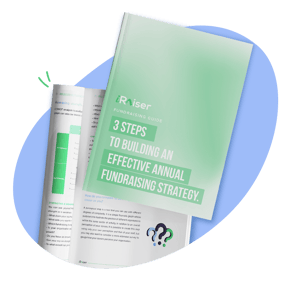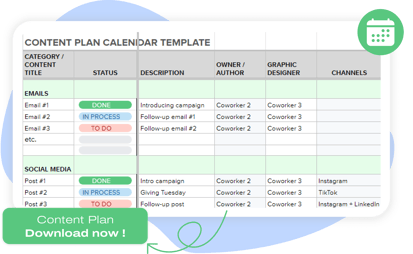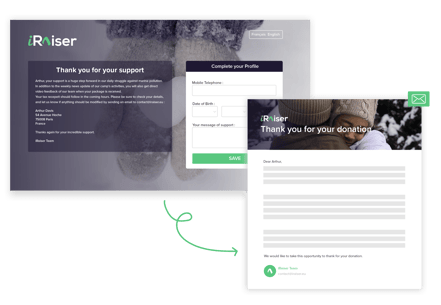As the calendar inches closer to the final stretch of the year, not-for-profit organisations and charities gear up for one of the most crucial periods in their fundraising efforts — end of the year fundraising campaigns! These campaigns are not just about celebrating the holiday season but are also a prime opportunity to secure a substantial portion of their annual funding. During this period, many charities may receive a significant portion or even the majority of their annual donations.
To navigate this pivotal time successfully, meticulous planning and strategic execution are essential.
Even if you don’t strictly follow a yearly plan, creating and adhering to a year-end fundraising plan is paramount. To kickstart your preparations for the most pivotal time of the year, we’ve compiled 6 fundamental steps you should consider as part of your fundraising strategy to ensure you are on track for a successful end of the year.
The ideal timeline for a year-end or Christmas fundraising campaign can vary depending on the size of your nonprofit organization, your donor base, and the complexity of your campaign. However, a general guideline for planning a successful year-end campaign might look like this:
- Aug - Oct: Define your plan and your goals
- Sept - Oct: Develop your campaign’s story & Content Plan
- Early to mid November: Pre-launch your year-end fundraising campaign
- Early December: Kick your year-end campaign launch into high-gear
- Mid-December to December 31st: Final Year-End Push
- January: Follow-up and Donor Appreciation
Aug - Oct: Define your fundraising plan and your goals
Start planning and strategizing for your year end campaign:
Initiating your year-end campaign planning well in advance is crucial for its success. Thisphase involves assembling your fundraising team, setting timelines, and outlining the campaign's overall strategy.
In order to do a proper plan, reviewing your budget and data from past year end campaigns is a valuable exercise.
-
Examine key performance metrics, such as total funds raised, donor retention rates, and engagement levels.
-
Identify trends and patterns. What strategies were effective, and which ones fell short of expectations? Use this analysis to fine-tune your approach for the current year.
-
Identify key campaign themes, messages, and the channels you'll utilise for outreach. Consider what worked well in past campaigns and what you might want to change.
-
Allocate resources and budget for the campaign, which should include costs for marketing materials, software, staff, and any other necessary expenses.
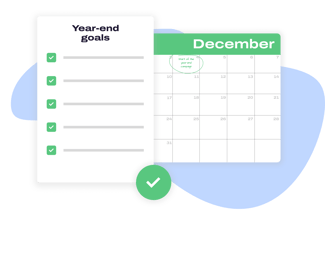
For more information on how to analyse your data correctly check out this article!
Set specific fundraising goals and objectives:
Clearly defined goals are the foundation of any successful fundraising campaign. Determine how much money you need to raise during the year-end campaign to support your organisation's mission and programs. Use the previous exercise of analysing last year’s results along with your budget, to help you define these goals.
A helpful strategy of setting goals is the SMART Goals method.
Here is a breakdown of what SMART goals are, and how to apply them to your charity:
-
Specific: Charity goals should be well-defined and clear. Instead of a vague goal like "increase donations," a specific goal might be "increase individual donations by 20% in the next fiscal year."
-
Measurable: Goals should have quantifiable criteria to track progress and determine when the goal has been met. Using the example above: increasing individual donations by 20% is measurable because it involves a specific percentage increase that can be tracked and measured over time.
-
Attainable: Goals should be realistic and achievable given the available resources and constraints. It's essential to set challenging goals, but charities must evaluate whether they have the capacity, manpower, and financial means to meet them.
-
Relevant: Goals should align with the charity's mission and overarching objectives.
-
Time-bound: Goals should have a specific timeframe for their beginning and completion. For instance, setting a deadline such as "increase individual donations by 20% by the end of the next fiscal year".
Begin segmenting your donor list based on giving history and engagement levels:
Not all donors are the same, and segmenting your donor list allows for more personalised and targeted communication.
Create segments based on factors like past giving history, donation frequency, donation amount, and engagement with your organisation (e.g., event attendance, volunteering).
Tailor your messaging and appeals to each segment, recognising that long-time donors may have different motivations than first-time or even major donors.
September - October: Develop your campaign’s story
Fundamental to the success of any charity fundraising campaign is a captivating story. When potential donors can relate to your cause on a personal level, they become more likely to support your campaign.
During this time period, develop compelling storytelling and content for your campaign. If you already have held end-of-the-year campaigns the previous years, see how you can keep the tradition going but add a new element to innovate and increase engagement. For some creative ideas, download our free fundraising guide!
Create a content calendar with key dates and milestones.
Make it as detailed as possible, planning the different types of content that you will launch, using which channel and at what time.
For example, will you begin your campaign with an email appeal? How many emails will you send and to which audience? Will you launch social media posts in parallel to your emails? Using google sheets or docs is a great way to keep track of everyone’s tasks, the different actions to be taken, and the deadlines.
Would you like to download this content plan template to use for your charity’s year-end campaign? Simply fill this short form below.
Prepare digital & print elements, most importantly your online donation forms
Take this time to prepare your site and online donation forms, along with any digital and print materials. This may include email templates, social media graphics, etc.
Making sure you have a dedicated donation page for your year-end campaign is key. With a powerful online fundraising platform you can create multiple forms that run simultaneously and conduct A/B testing. Changing the donation amounts, a visual, or whether it’s a one-column or 3-column form can really make a difference. Don’t be afraid to use testing to help you determine what your audience responds to in the best way, and even more importantly, adjust your approach accordingly for the next year.
Early to mid November: Pre-launch your year-end fundraising campaign
Launch your campaign in early to mid-November. Starting early allows you to capture the attention of potential donors before the holiday season frenzy begins. It provides a window of opportunity to engage supporters and collect donations before they get inundated with other holiday expenses or appeals.
Start promoting your campaign on your website and through other digital channels.
Ensure your website prominently features details about the year-end campaign, including the campaign's goals, progress tracking, and ways to donate.
Parallel to this send out your first campaign emails. Remember to keep your different types of donors in mind. Highlight the campaign's purpose, the impact of their support, and a clear call to action (CTA) to make a donation. Simultaneously, make announcements on your social media platforms to create awareness.

Tip: Use other digital channels like blogs, ambassadors’ social profiles, videos, or podcasts to tell compelling stories about your cause and how donations make a difference. Use email newsletters to keep supporters informed and engaged throughout the campaign.
Host a campaign kickoff event if you can.
A campaign kickoff event can generate excitement and engagement. It's an opportunity to explain the campaign's objectives and inspire your supporters. This event could be virtual or in-person.
If you need help organising a successful event, check out this article with a step-by-step guide!
Leverage GivingTuesday as the launchpad for your end-of-year campaign.
While putting together your overall strategy, it's important to factor in #GivingTuesday, as this day can yield substantial results with a clear plan of action.

Even if you opt not to run a full-fledged fundraising campaign on this international day of generosity, it's important your donors are aware of how they can contribute to your cause on this day.
Consider employing one or more of the following strategies to connect with your supporters on #GivingTuesday:
-
Encourage your donors to save a percentage of what they would spend on Black Friday and give it towards your cause.
-
Encourage supporters to create their own peer-to-peer fundraising initiative in your name. If you have a fundraising tool like a peer to peer fundraising platform, your supporter can create personal fundraising pages easily and seamlessly.
-
Encourage your community to share your organisation's posts highlighting your impact on social media and through email. Giving Tuesday’s website provides plenty of templates for you to use.
-
You can lead by example, and do your own good deed, by personally reaching out to your donors to express your gratitude.
Early December: Kick your year end campaign launch into high-gear!
Intensify your campaign efforts with more frequent communication.
Send out regular updates via email, social media, and other digital channels. Share compelling stories, milestones, and the impact of donations to remind supporters of the difference they can make.
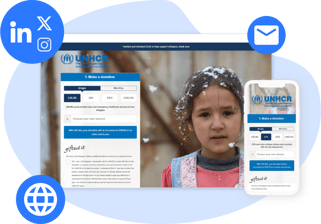
Consider running a mid-campaign giving event or challenge to boost donations.
These can be time-limited initiatives designed to motivate donors to give. For instance, you could create a 24-hour donation matching challenge, where every donation made within a specific time frame is matched by a generous donor or sponsor. Challenges like these can create urgency and excitement, encouraging more contributions.
Remind your supporters they can benefit from a fiscal return if they give at this time (depending on your region)
Clearly outline how your supporters can benefit from tax deductions or credits when they contribute to your cause during the year-end campaign. Detail the specific tax advantages applicable to your region, such as deductions on income taxes or reductions in the overall tax liability.
Implement a follow-up strategy for donors who have already given.
Your relationship with donors doesn't end when they make their contributions. Implement a thoughtful follow-up strategy to express your gratitude and keep them engaged. Update them on the progress of the campaign and how their support is making an impact. Continue to involve them in your organisation's activities and inform them about future initiatives.
Mid-December to December 31st: Final Year End Campaign Push
Create urgency. Focus on year-end giving during the last two weeks of December when donations typically peak. To maximise year-end giving, create urgent and emotionally resonant messages that convey the critical nature of your mission and the impending deadline. Use persuasive storytelling to highlight the impact of donations and why they are needed urgently.

Being transparent is key at this time. Share progress and how close you are to reaching your goal. This not only builds trust but also motivates donors to help you achieve that final push. Even if you did not reach your goal, share this in a positive way to motivate others to help you achieve it next year.
Make it even easier for donors to give with simple and secure online donation options. Like we mentioned in your preparation stage, streamline the donation process with user-friendly, secure online options. Try to reduce the amount of information you request from supporters when making a donation (ex. address, phone number etc).
Ask for the minimum, and whatever other data you need, you can request it on the Thank You page, once they have completed their donation. Simplifying the process minimises barriers to giving, and securing the donation is always the first priority.
Consistent communication is vital. Continue to engage with donors through social media and email. Maintain a strong presence by providing updates, expressing gratitude, and sharing compelling stories.
January: Follow-up and Donor Appreciation
First and foremost, thank your donors promptly. At the end of your campaign, it's of utmost importance to almost immediately share your heartfelt appreciation to your generous community of supporters.
This simple yet profound gesture plays a pivotal role in fortifying your relationship and in nurturing a positive image towards your charity. Send thank-you messages promptly, acknowledging the impact of their contributions and reaffirming the value of their support. For ideas and best practices on how to thank your donors read this article!
Provide a summary of the campaign's impact and results. Include the total funds raised, the projects or initiatives supported, and any milestones reached. Show donors the tangible difference their contributions have made.
Analyse the campaign's performance and gather feedback from donors. Evaluate the campaign's performance by analysing data, such as the number of new or recurring donors, donation amounts, and engagement levels.
Gather feedback from donors through surveys or direct communication to understand what worked well and where improvements can be made. You can create free and easy surveys using Google Forms. This information is essential for refining and improving your future campaigns.
Finally, begin planning for next year's campaign. Post-campaign is an excellent time to start planning for the next year. Use the insights gained from the campaign analysis and donor feedback to form your strategy for the upcoming year. Setting goals, creating a timeline, and identifying new opportunities will give you a head start in your preparations.
In the final stretch of the year, strategically channelling your efforts to harness the peak in year-end giving can be quite beneficial for any charity. Remember to create a sense of urgency, maintain open communication, and simplify the donation process, while continuing to engage with your donors. Most importantly, always THANK your supporters. This approach can significantly impact your end of the year fundraising success.
Using this year-end fundraising strategy and timeline can help you navigate through a period, which can be overwhelming, with a clear plan. Keep in mind that this timeline is a general guideline and can be adjusted to fit your organisation's specific needs. Regularly monitor your campaign's performance and be flexible in making adjustments as needed throughout the process.
Already wondering how to get started on your annual fundraising strategy? Check out this guide! With tools, tips and practical exercises to help you prepare for a successful fundraising year.